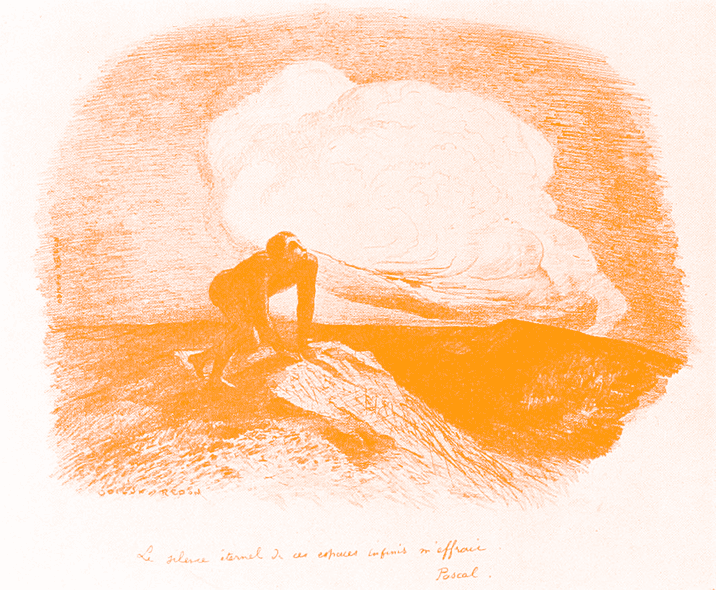As I walk the railroad causeway I am, as the last two months, disturbed by the sounds of my steps on the frozen ground. I wish to hear the silence of the night, for the silence is something positive and to be heard. I cannot walk with my ears covered. I must stand still and listen with open ears, far from the noises of the village, that the night may make its impression on me. A fertile and eloquent silence. Sometimes the silence is merely negative, an arid and barren waste in which I shudder, where no ambrosia grows. I must hear the whispering of a myriad voices. Silence alone is worthy to be heard. Silence is of various depth and fertility, like soil.
H. D. T., Journal (January 21st, 1853)1
Il y a une formule en poésie qui correspond à cette expérience. La structure traditionnelle du langage est dissoute. Plus de grammaire. Plus de syntaxe. Les éléments actifs sont uniquement des mots. La règle du jeu est la permutation. Les poèmes qui en découlent sont nommés «constellations».
Celles-ci constituent un programme poétique.
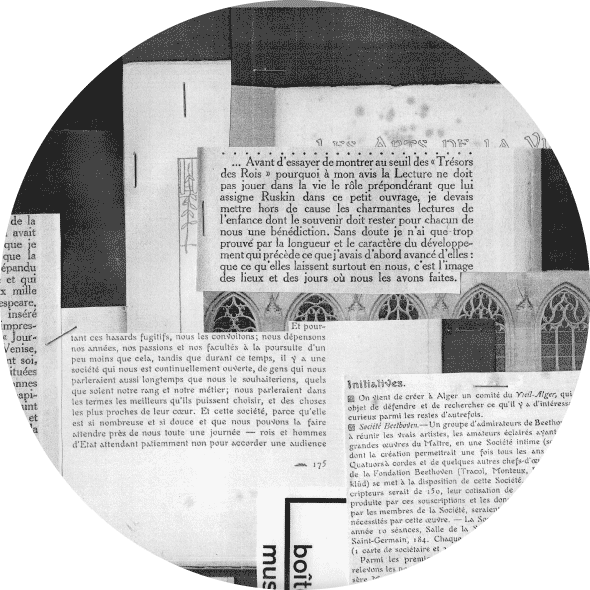
ce qu’elles laissent surtout en nous, c’est l’image des lieux et des jours où nous les avons faites.
De cette suite de sons ordonnés selon les lois du rythme et de la modulation il en résulte un air agréable à entendre: l’expérience d’un milieu terrestre particulier, qu’il soit défini par le relief que l’on arpente, par le sol sur lequel s’amassent les pages blanches, par le climat, par l’encre qui s’écoule ou bien par la végétation qui nous recouvre.
Les connaissances les plus précises, les plus évidentes de l’écrivain reposent sur leurs objets comme des insectes sur des feuilles, des fleurs ou des branches, ne trahissant rien de leur présence jusqu’à ce que qu’un saut, un battement d’aile, un bond révèle à l’observateur effrayé qu’une vie propre s’est inopinément et insensiblement insinuée dans un monde étranger.
W. B, L’image proustienne2
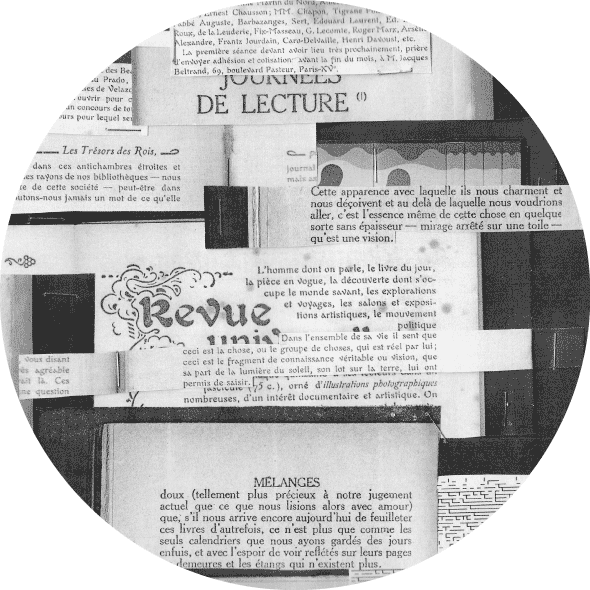
Dans l’ensemble de sa vie il sent que ceci est la chose, ou le groupe de choses, qui est réel par lui; ceci est le fragment de connaissance véritable ou vision, que sa part de la lumière du soleil, son lot sur la terre, lui ont permis de saisir.
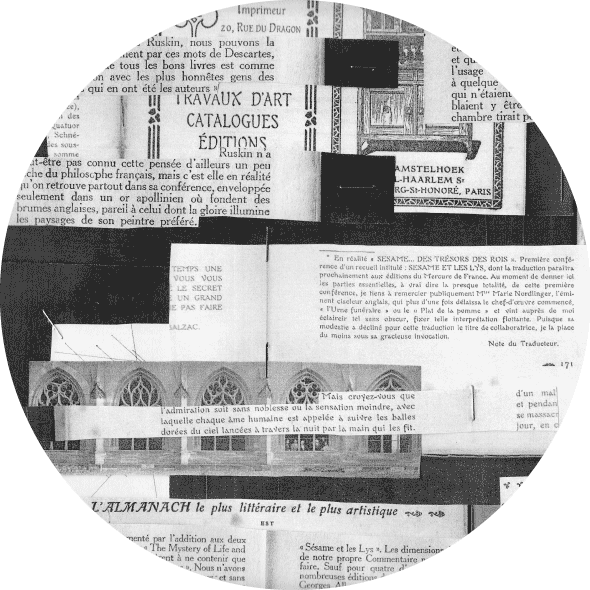
Mais croyez-vous que l’admiration soit sans noblesse ou la sensation moindre, avec laquelle chaque âme humaine est appelée à suivre les balles dorées du ciel lancées à travers la nuit par la main qui les fit.
Au centre du grand dôme, le lecteur active un dispositif complexe fait de boutons, de cadrans et de leviers. Avec plus de deux mille combinaisons possibles, il semble être aux commandes de l’univers tout entier.
Knowing the past is as astonishing a performance as knowing the stars. Astronomers look only at old light. There is no other light for them to look at. This old light of dead or distant stars was emitted long ago and it reaches us only in the present. Many historical events, like astronomical bodies, also occur long before they appear, such as secret treaties; aide-memoires, or important works of art made for ruling personages. The physical substance of these documents often reaches qualified observers only centuries or millennia after the event. Hence astronomers and historians have this in common: both are concerned with appearances noted in the present but occurring in the past.
G. K. The Shape of Time: Remarks on the History of Things3
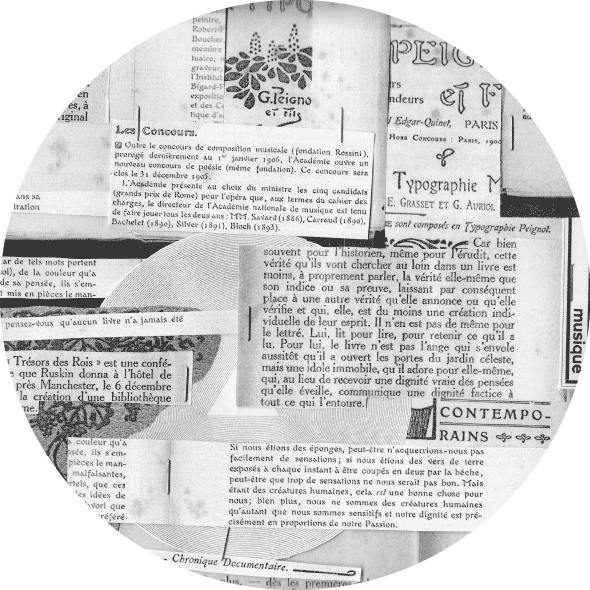
Car bien souvent pour l’historien, même pour l’érudit, cette vérité qu’ils vont chercher au loin dans un livre est moins, à proprement parler, la vérité elle-même que son indice ou sa preuve
Un jeu d’enfant peut-il être à l’origine de ces «constellations»? Le programme est-il constitué d’éléments destinés à être assemblés durant ce jeu?
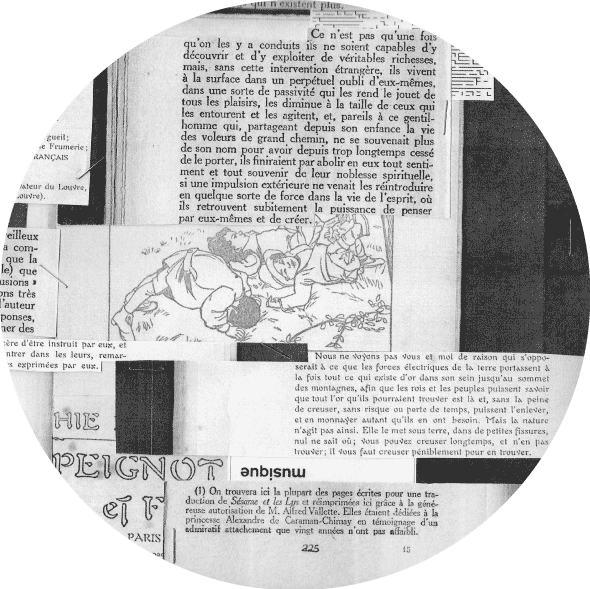
ils finiraient par abolir en eux tout sentiment et tout souvenir de leur noblesse spirituelle, si une impulsion extérieure ne venait les réintroduire en quelque sorte de force dans la vie de l’esprit, où ils retrouvent subitement la puissance de penser par eux-mêmes et de créer.
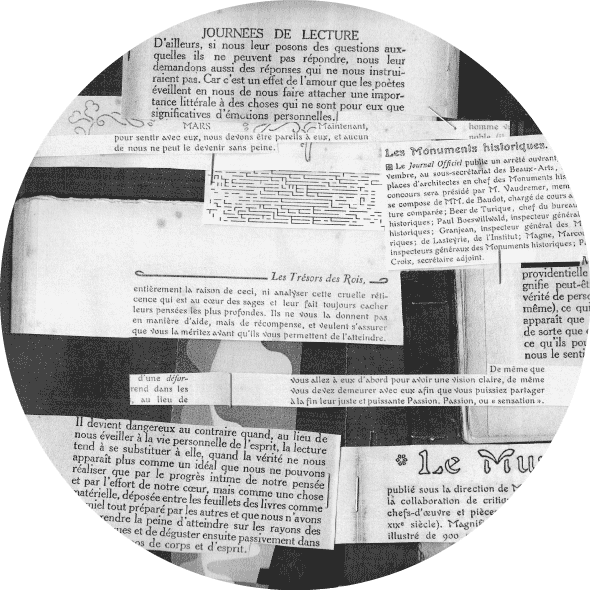
De même que vous allez à eux d’abord pour avoir une vision claire, de même vous devez demeurer avec eux afin que vous puissiez partager à la fin leur juste et puissante Passion, Passion, ou «sensation».
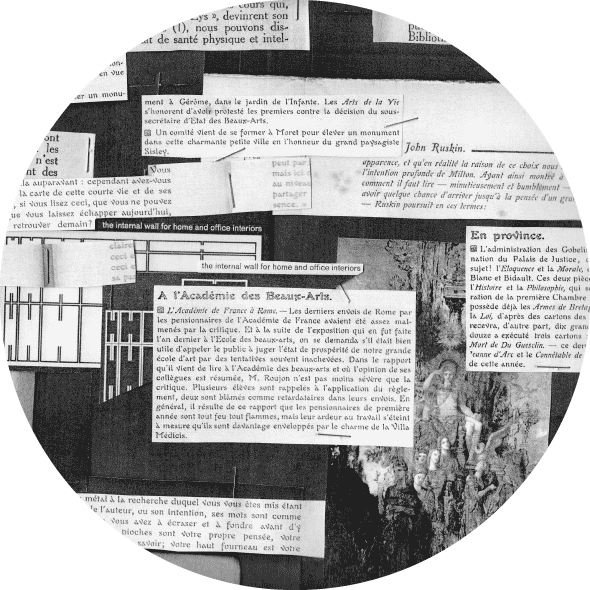
En général, il résulte de ce rapport que les pensionnaires de première année sont tout feu tout flammes, mais leur ardeur au travail s’éteint à mesure qu’ils sont davantage enveloppés par le charme de la Villa Médicis.
Contempler l’ensemble de cette réalité matérielle et/ou mettre en forme des connaissances sur un sujet donné — sans le secours de la parole.
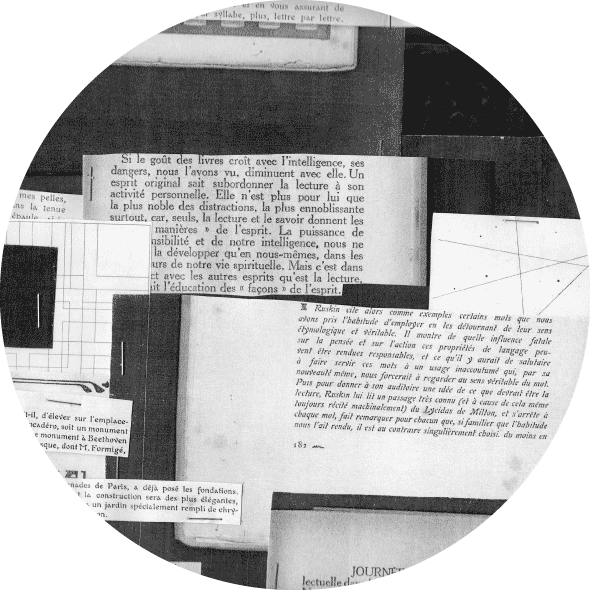
Ruskin cite alors comme exemples certains mots que nous avons pris l’habitude d’employer en les détournant de leur sens étymologique et véritable. Il montre de quelle influence fatale sur la pensée et sur l’action ces propriétés de langage peuvent être rendues responsables, et ce qu’il y aurait de salutaire à faire servir ces mots à un usage inaccoutumé qui, par sa nouveauté même, nous forcerait à regarder au sens véritable du mot.
Words are signs of natural facts.4
Particular natural facts are symbols of particular facts.5
Nature is the symbol of spirits.6R. W. E. Nature
Certains projets de construction, de restauration ou d’aménagement des édifices pourraient correspondre à ce principe de recherche. Des unités d’habitation pourraient être édifiées à partir de blocs de construction élémentaires.
Nature is an inifite sphere, whose center is everywhere and whose circumference is nowhere.
P.7
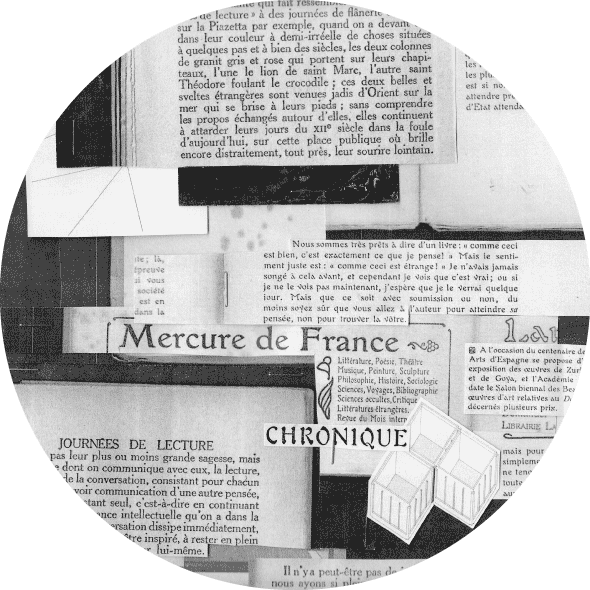
Littérature, Poésie, Théâtre, Musique, Peinture, Sculpture, Philosophie, Histoire, Sociologie, Sciences, Voyages, Bibliographie, Sciences occultes, Critique, Littératures étrangères.
Il s’agit de cubes de la taille de la plus petite surface habitable. Le format de chacun des cubes répond à certaines contraintes économiques ainsi qu’à des paramètres logistiques relatifs au transport et au montage. Chaque bloc est en béton armé, quatre poteaux aux quatre coins de la structure permettant de soutenir la totalité de la charge verticale. Les paroies raidies ainsi que les deux planchers complètent la stabilité d’ensemble de la structure. Chaque unité peut être utilisée pour étendre la surface, selon les besoins. Des cubes peuvent être ajoutés horizontalement, l’espace entre les blocs pouvant être isolé et utilisé pour l’emplacement des différents réseaux. Verticalement, les cubes peuvent être empilés à la manière de tasses à café, et ce jusqu’à huit étages. Chaque espace peut être subdivisé, des portes et des fenêtres peuvent être insérés. Chaque cube peut être utilisé comme élément d’ossature en vue de la construction d’espaces décloisonnés.
Six squares of transparent material, one having points of 4 sizes: the 13 very small ones are single sounds; the 7 small but larger ones are 2 sounds; the 3 of greater size are 3 sounds; the 4 largest 4 or more sounds.
Pluralities are played together or as “constellations”. In using pluralities, an equal number of the 5 other squares (having 5 lines each) are to be used for determinations, or equal number of positions, — each square having 8.
The 5 lines are: lowest frequency, simplest overtone structure, greatest amplitude, least duration, and earliest occurence within a decided upon time.
Perpendiculars from points to lines give distances to be measured or simply observed. Any number of performers; any kind and number of instruments.
J. C., Variations I8
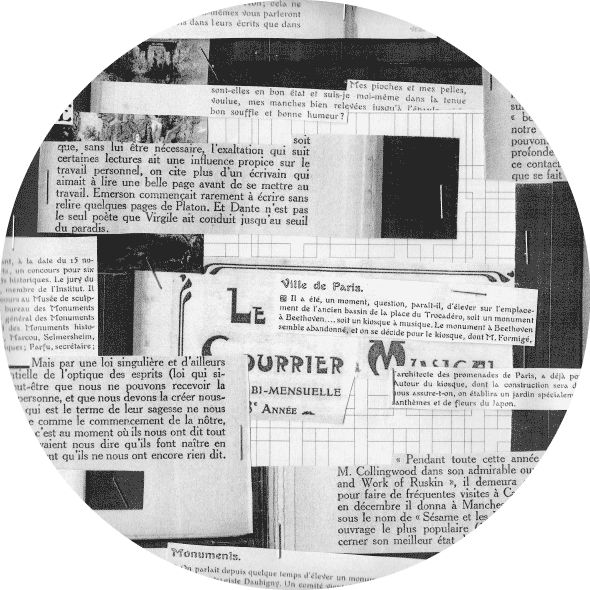
Il a été, un moment, question, paraît-il, d’élever sur l’emplacement de l’ancien bassin de la place du Trocadéro, soit un monument à Beethoven… soit un kiosque à musique. Le monument à Beethoven semble abandonné, et on se décide pour le kiosque, dont M. Formigé,
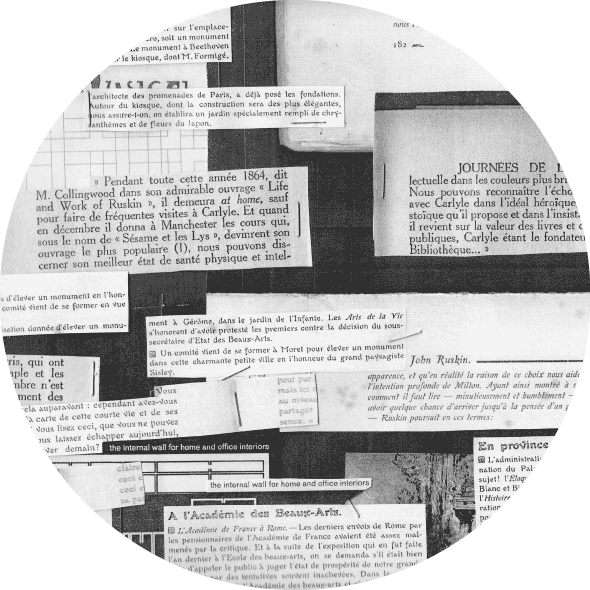
architecte des promenades de Paris, a déjà posé les fondations. Autour du kiosque, dont la construction sera des plus élégantes, nous assure-t-on, on établira un jardin spécialement rempli de chrysanthèmes et de fleurs du Japon.
À quelques pas du magasin de disques «boîte à musique» se trouve le café à l’enseigne du «temps perdu». Le nom, composé en bas-de-casse, est encadré par un filet noir qui résonne de manière surprenante du fait de cette proximité. Aussi, il est difficile d’identifier le matériau utilisé ou d’affirmer avec précision si son installation est antérieure à celle du commerce voisin. Après inspection, il semble que l’enseigne soit partiellement démontée.
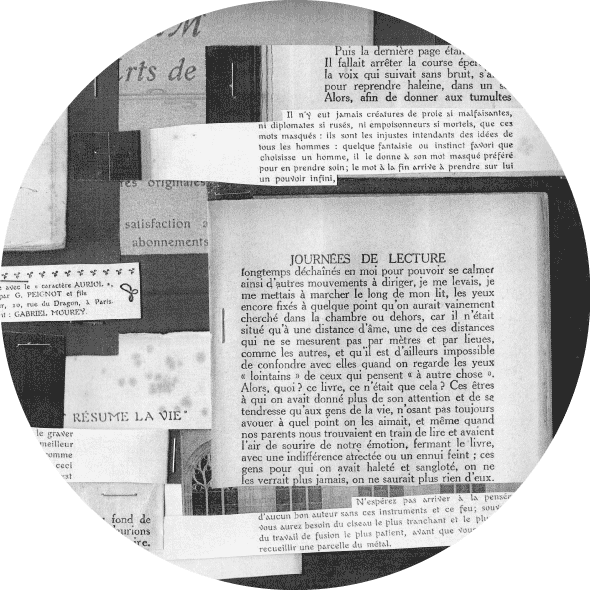
Alors, quoi? ce livre, ce n’était que cela? Ces êtres à qui on avait donné plus de son attention et de sa tendresse qu’aux gens de la vie, n’osant pas toujours avouer à quel point on les aimait, et même quant nos parents nous trouvaient en train de lire et avaient l’air de sourire de notre émotion, fermant le livre, avec une indifférence affectée ou un ennui feint; ces gens pour qui on avait haleté et sangloté, on ne les verrait plus jamais, on ne saurait plus rien d’eux.
Car ici c’est le jour qui défait ce qu’a fait la nuit. Chaque matin, lorsque nous nous réveillons, nous ne tenons en main, en général faibles et lâches, que quelques franges de la tapisserie du vécu que l’oubli a tissée en nous. Mais chaque jour, avec nos actions orientées vers des fins précises et, davantage encore, avec notre mémoire captive de ces fins, nous défaisons les entrelacs, les ornements de l’oubli. C’est pourquoi, à la fin de sa vie, Proust avait changé le jour en nuit: dans une chambre obscure, à la lumière artificielle, sans être dérangé, il pouvait consacrer toutes ses heures à son travail et ne laisser échapper aucune des arabesques entrelacées.
W. B., L’image proustienne
- in Jeffrey S. Cramer (ed.). I to Myself: an annotated selection from the journal of H. D. Thoreau, Yale University Press, New Haven, 2007 [↩]
- Note du traducteur, Rainer Rochlitz: Première publication dans les numéros 25, 26 et 27 de Die literarische Welt, 21 et 28 juin, 5 juillet 1929. Le texte traduit est celui d’une version ultérieure qui peut être datée de 1934. Rappelons que Benjamin est à la même époque le principal maître d’œuvre de la première traduction allemande de la Recherche du temps perdu; ont paru: À l’ombre des jeunes filles en fleurs, 1927 et Le Côté de Guermantes, 1930; rééd. des deux tomes dans le cadre des Gesammelte Schriften, Francfort-sur-le-Main, Suhrkamp, 1987; restée inédite, la traduction de Sodome et Gomorrhe n’a pas été retrouvée. [↩]
- Yale University Press, 1962 [↩]
- Words are signs of natural facts. The use of natural history is to give us aid in supernatural history. The use of the outer creation is to give us language for the beings and changes of the inward creation. Every word which is used to express a moral or intellectual fact, if traced to its root, is found to be borrowed from some material appearance. Right originally means straight; wrong means twisted. Spirit primarily means wind; transgression, the crossing of a line; supercilious, the raising of the eye-brow. We say the heart to express emotion, the head to denote thought; and thought and emotion are, in their turn, words borrowed from sensible things, and now appropriated to spiritual nature. Most of the process by which this transformation is made, is hidden from us in the remote time when language was framed ; but the same tendency may be daily observed in children. Children and savages use only nouns or names of things, which they continually convert into verbs, and apply to analogous mental acts. [↩]
- But this origin of all words that convey a spiritual import, — so conspicuous a fact in the history of language, — is our least debt to nature. It is not words only that are emblematic; it is things which are emblematic. Every natural fact is a symbol of some spiritual fact. Every appearance in nature corresponds to some state of the mind, and that state of the mind can only be described by presenting that natural appearance as its picture. An enraged man is a lion, a cunning man is a fox, a firm man is a rock, a learned man is a torch. A lamb is innocence; a snake is subtle spite; flowers express to us the delicate affections. Light and darkness are our familiar expression for knowledge and ignorance; and heat for love. Visible distance behind and before us, is respectively our image of memory and hope.
Who looks upon a river in a meditative hour, and is not reminded of the flux of all things? Throw a stone into the stream, and the circles that propagate themselves are the beautiful type of all influence. Man is conscious of a universal soul within or behind his individual life, wherein, as in a firmament, the natures of Justice, Truth, Love, Freedom, arise and shine. This universal soul, he calls Reason: it is not mine or thine or his, but we are its; we are its property and men. And the blue sky in which the private earth is buried, the sky with its eternal calm, and full of everlasting orbs, is the type of Reason. That which, intellectually considered, we call Reason, considered in relation to nature, we call Spirit. Spirit is the Creator. Spirit hath life in itself. And man in all ages and countries, embodies it in his language, as the Father.It is easily seen that there is nothing lucky or capricious in these analogies, but that they are constant, and pervade nature. These are not the dreams of a few poets, here and there, but man is an analogist, and studies relations in all objects. He is placed in the centre of beings, and a ray of relation passes from every other being to him. And neither can man be understood without these objects, nor these objects without man. All the facts in natural history taken by themselves, have no value, but are barren like a single sex. But marry it to human history, and it is full of life. Whole Floras, all Linnaeus’ and Buffon’s volumes, are but dry catalogues of facts; but the most trivial of these facts, the habit of a plant, the organs, or work, or noise of an insect, applied to the illustration of a fact in intellectual philosophy, or, in any way associated to human nature, affects us in the most lively and agreeable manner. The seed of a plant, to what affecting analogies in the nature of man, is that little fruit made use of, in all discourse, up to the voice of Paul, who calls the human corpse a seed, — « It is sown a natural body; it is raised a spiritual body. » The motion of the earth round its axis, and round the sun, makes the day, and the year. These are certain amounts of brute light and heat. But is there no intent of an analogy between man’s life and the seasons? And do the seasons gain no grandeur or pathos from that analogy? The instincts of the ant are very unimportant considered as the ant’s; but the moment a ray of relation is seen to extend from it to man, and the little drudge is seen to be a monitor, a little body with a mighty heart, then all its habits, even that said to be recently observed, that it never sleeps, become sublime.
Because of this radical correspondence between visible things and human thoughts, savages, who have only what is necessary, converse in figures. As we go back in history, language becomes more picturesque, until its infancy, when it is all poetry; or, all spiritual facts are represented by natural symbols. The same symbols are found to make the original elements of all languages. It has moreover been observed, that the idioms of all languages approach each other in passages of the greatest eloquence and power. And as this is the first language, so is it the last. This immediate dependence of language upon nature, this conversion of an outward phenomenon into a type of somewhat in human life, never loses its power to affect us. It is this which gives that piquancy to the conversation of a strong-natured farmer or back-woodsman, which all men relish.
Thus is nature an interpreter, by whose means man converses with his fellow men. A man’s power to connect his thought with its proper symbol, and so utter it, depends on the simplicity of his character, that is, upon his love of truth and his desire to communicate it without loss. The corruption of man is followed by the corruption of language. When simplicity of character and the sovereignty of ideas is broken up by the prevalence of secondary desires, the desire of riches, the desire of pleasure, the desire of power, the desire of praise, — and duplicity and falsehood take place of simplicity and truth, the power over nature as an interpreter of the will, is in a degree lost; new imagery ceases to be created, and old words are perverted to stand for things which are not; a paper currency is employed when there is no bullion in the vaults. In due time, the fraud is manifest, and words lose all power to stimulate the understanding or the affections. Hundreds of writers may be found in every long-civilized nation, who for a short time believe, and make others believe, that they see and utter truths, who do not of themselves clothe one thought in its natural garment, but who feed unconsciously upon the language created by the primary writers of the country, those, namely, who hold primarily on nature.
But wise men pierce this rotten diction and fasten words again to visible things; so that picturesque language is at once a commanding certificate that he who employs it, is a man in alliance with truth and God. The moment our discourse rises above the ground line of familiar facts, and is inflamed with passion or exalted by thought, it clothes itself in images. A man conversing in earnest, if he watch his intellectual processes, will find that always a material image, more or less luminous, arises in his mind, cotemporaneous with every thought, which furnishes the vestment of the thougoht. Hence, good writing and brilliant discourse are perpetual allegories. This imagery is spontaneous. It is the blending of experience with the present action of the mind. It is proper creation. It is the working of the Original Cause through the instruments he has already made.
These facts may suggest the advantage which the country-life possesses for a powerful mind, over the artificial and curtailed life of cities. We know more from nature than we can at will communicate. Its light flows into the mind evermore, and we forget its presence. The poet, the orator, bred in the woods, whose senses have been nourished by their fair and appeasing changes, year after year, without design and without heed, — shall not lose their lesson altogether, in the roar of cities or the broil of politics. Long hereafter, amidst agitation and terror in national councils, — in the hour of revolution, these solemn images shall reappear in their morning lustre, as fit symbols and words of the thoughts which the passing events shall awaken. At the call of a noble sentiment, again the woods wave, the pines murmur, the river rolls and shines, and the cattle low upon the mountains, as he saw and heard them in his infancy. And with these forms, the spells of persuasion, the keys of power are put into his hands. [↩]
- We are thus assisted by natural objects in the expression of particular meanings. But how great a language to convey such peppercorn informations! Did it need such noble races of creatures, this profusion of forms, this host of orbs in heaven, to furnish man with the dictionary and grammar of his municipal speech? Whilst we use this grand cipher to expedite the affairs of our pot and kettle, we feel that we have not yet put it to its use, neither are able. We are like travellers using the cinders of a volcano to roast their eggs. Whilst we see that it always stands ready to clothe what we would say, we cannot avoid the question, whether the characters are not significant of themselves. Have mountains, and waves, and skies, no significance but what we consciously give them, when we employ them as emblems of our thoughts? The world is emblematic. Parts of speech are metaphors because the whole of nature is a metaphor of the human mind. The laws of moral nature answer to those of matter as face to face in a glass.
« The visible world and the relation of its parts, is the dial plate of the invisible. » The axioms of physics translate the laws of ethics. Thus, « the whole is greater than its part; » « reaction is equal to action; » « the smallest weight may be made to lift the greatest, the difference of weight being compensated by time; » and many the like propositions, which have an ethical as well as physical sense. These propositions have a much more extensive and universal sense when applied to human life, than when confined to technical use.
In like manner, the memorable words of history, and the proverbs of nations, consist usually of a natural fact, selected as a picture or parable of a moral truth. Thus; A rolling stone gathers no moss; A bird in the hand is worth two in the bush; A cripple in the right way, will beat a racer in the wrong; Make hay whilst the sun shines; ‘T is hard to carry a full cup even; Vinegar is the son of wine; The last ounce broke the camel’s back; Long-lived trees make roots first; — and the like. In their primary sense these are trivial facts, but we repeat them for the value of their analogical import. What is true of proverbs, is true of all fables, parables, and allegories.
This relation between the mind and matter is not fancied by some poet, but stands in the will of God, and so is free to be known by all men. It appears to men, or it does not appear. When in fortunate hours we ponder this miracle, the wise man doubts, if, at all other times, he is not blind and deaf;
« Can these things be,
And overcome us like a summer’s cloud,
Without our special wonder? »for the universe becomes transparent, and the light of higher laws than its own, shines through it. It is the standing problem which has exercised the wonder and the study of every fine genius since the world began; from the era of the Egyptians and the Brahmins, to that of Pythagoras, of Plato, of Bacon, of Leibnitz, of Swedenborg. There sits the Sphinx at the road-side, and from age to age, as each prophet comes by, he tries his fortune at reading her riddle. There seems to be a necessity in spirit to manifest itself in material forms; and day and night, river and storm, beast and bird, acid and alkali, preexist in necessary Ideas in the mind of God, and are what they are by virtue of preceding affections, in the world of spirit. A Fact is the end or last issue of spirit. The visible creation is the terminus or the circumference of the invisible world. « Material objects, » said a French philosopher, « are necessarily kinds of scoriæ of the substantial thoughts of the Creator, which must always preserve an exact relation to their first origin; in other words, visible nature must have a spiritual and moral side. »
This doctrine is abstruse, and though the images of « garment, » « scoriæ, » « mirror, » &c., may stimulate the fancy, we must summon the aid of subtler and more vital expositors to make it plain. « Every scripture is to be interpreted by the same spirit which gave it forth, » — is the fundamental law of criticism. A life in harmony with nature, the love of truth and of virtue, will purge the eyes to understand her text. By degrees we may come to know the primitive sense of the permanent objects of nature, so that the world shall be to us an open book, and every form significant of its hidden life and final cause.
A new interest surprises us, whilst, under the view now suggested, we contemplate the fearful extent and multitude of objects; since « every object rightly seen, unlocks a new faculty of the soul. » That which was unconscious truth, becomes, when interpreted and defined in an object, a part of the domain of knowledge, — a new amount to the magazine of power. [↩]
- in Mel Bochner & Robert Smithson, « The Domain of the Great Bear », Art Voices, Fall 1966 [↩]
- For David Tudor, on his birthday (Tardily) [↩]
